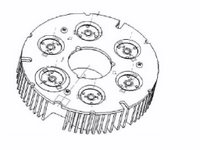The physical universe is a lossy place. Most energy conversions are terribly wasteful in the scale the universe works on. The earth is a solar driven planet and probably consumes 0.0000000000001 % (I made up this number and it is probably an overestimate by a factor of a few billion) of the sun's output to function as a living planet. As small bits of self organized carbon living in a micro-energy system within this lossy macro-energy regime we don't have the luxury of using a fraction of the harvested energy and dispensing with the rest.
The key issues hindering PV adoption today are the conversion efficiencies and hence cost per watt. After all with the possible exception of geo-thermal energy, it can be argued that all forms of energy in this planet (Coal, Oil, Wind, Tidal, Solar et al) are derivatives of solar energy. All we are trying to do is to use the solar energy directly rather than wait for millions of years for the trees to grow, get converted to coal and burn it to produce electricity. I guess the term 'investment efficacy' will be appropriate in this context as the PV index which needs to be raised. The theme of this monograph will therefore be on strategies on raising the investment efficacy of PV and the downstream applications or what is more appropriately the solar application eco-system. Generation of energy is not an end in itself. There is a specific function that the energy is used for. With PV, Lighting seems to be by far the biggest application.Let me start by defining three basic rules of play.
1. The investment efficacy of any electrical system is a sum of all the efficacies at play.
2. Efficacy of a system can be raised by either a physics solution or a financial solution.
3. There are many ways to skin the cat. (More on this aspect in a future followup)
Having defined the basic universe in terms of its physics, the facts and the possible solutions to this problem can be stated and analyzed as below.
Level 1:
A BOM for a typical power system has
1. PV modules - 12- 15 % efficiency in conversion of radiant energy to electricity.
2. Charge controllers - 60 % efficiency in regulating and charging battery with input current.
3. Battery bank - 80 % efficiency in charge and discharge cycles
4. Inverter (optional) - 60 - 85 % efficiency depending power factor
5. Wires, switches and connectors - 95 % efficiency in conduction
As per convention, the average solar constant at sea level is about 1kW/m^2.
The typical setup illustrated above will generate the following
Assuming a system operating voltage of 12 V and a PV collector of 1 m^2
Output at PV module = 15% of 1 KW = 150 W
Output at Charge controller = 60 % of 150Wp = 90W
Output at battery terminals = 80 % of 90Wp = 72 W
Output at device (wire load) = 95 % of 72 Wp = 68.5W
In the collection and utilization of a potential of 1KW the average figure of usable electricity appears to be 69W ! The above calculation is simplistic and illustrates a typical rather than a best case. However it illustrates the pain point of PV, material science. With a start of chain efficiency of 15 % this is the best we can do.
The next factor is how efficiently the power thus gathered is used in a lighting context
6. Device efficiency - Incandescent - 5- 10 % , fluorescent - 40- 50 %, LED - 40 - 80 % (colour dependent)
so output of usable light = 6.9 W (Incandescent), 34.5 W (Fluorescent), 55.2 W (LED lamps)
There is no shortage of energy in this world, just shortage of good technologies to boost yields in harvesting and usage. If the best technologies in each of these areas are applied the following will be numbers
Level 2:
The efficiencies described below are possible with today's technology and not just speculation
1. PV modules - 30 - 50 %
2. Charge controllers - 95 %
3. Battery bank - 90 %
4. Inverter (optional) - 90 %
5. Wires, switches and connectors - 98%
6. Device efficiency - 85 % (assuming solid state LED lighting)
The same 1 m^2 harvest of solar energy will now yield 320.5 W of usable lighting. (More actually as we dont need inversion for LED lighting, however we can leave it at this for sake of an apples to apples comparison).
55.2W vs 320.5W !! A 580 % increase in system efficiency. And this is only 32 % total system efficiency (when measured against how much energy we are grabbing from the incident sunlight) which probably compares favorably with an IC engine.
When the efficiency of the system has potential for such dramatic rise, it is clear that an equal and opposite effect will influence the costing of such systems. PV at even 50 % of today's costs will increase adoption by about 10 times. So the effect can be self sustaining.
As this simplistic model demonstrated there is a lot more than can be squeezed out of PV today that can spur adoption. What is required seems to be a concerted effort to increase the efficiencies of all the components in the PV chain including the devices that consume the power. The smart money on PV should logically go after investments in efficiency optimization rather than something totally new. Raising downstream efficiency even in the lamps equates to using less PV per function. As the PV industry competes for raw material with much higher value products (like CPU's or memory chips) the less used for a given application, the better its salability.


































